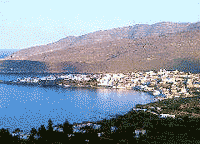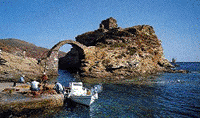 Andros island, most northerly and second largest of the Cyclades group of Greek Aegean Islands,380 square km in area. Its terrain is composed of ranges of mountains separated by river beds, gorges and valleys planted with vines and fruit trees. The capital of the island is Andros, or Hora, and it's also one of its ports, the principal one being Gavrio. Andros was the birth place of many ship-owners and its Naval museum, in Hora, is a testament to that. Also in Hora there is an Archaeological Museum with Geometric, Classic, Hellenistic, Roman and Byzantine exhibits, as well as a Museum of Modern Art. Sea lovers can find good swimming beaches at Hora, Nimborio, Paraporti and in the small bays of Yiala and Pisso Yiala. Wooded, well-watered, and mountainous, it is an eparkhía ("eparchy"), with its capital at the town of Ándros, on the east coast. South of the capital is the port of Korthion; to the north, the Palaiokastron 625 m, with ruins of a Venetian castle and medieval town. The ruins of Palaeopolis, the ancient capital, support a hamlet, Palaiopolis, on the western coast.
Andros island, most northerly and second largest of the Cyclades group of Greek Aegean Islands,380 square km in area. Its terrain is composed of ranges of mountains separated by river beds, gorges and valleys planted with vines and fruit trees. The capital of the island is Andros, or Hora, and it's also one of its ports, the principal one being Gavrio. Andros was the birth place of many ship-owners and its Naval museum, in Hora, is a testament to that. Also in Hora there is an Archaeological Museum with Geometric, Classic, Hellenistic, Roman and Byzantine exhibits, as well as a Museum of Modern Art. Sea lovers can find good swimming beaches at Hora, Nimborio, Paraporti and in the small bays of Yiala and Pisso Yiala. Wooded, well-watered, and mountainous, it is an eparkhía ("eparchy"), with its capital at the town of Ándros, on the east coast. South of the capital is the port of Korthion; to the north, the Palaiokastron 625 m, with ruins of a Venetian castle and medieval town. The ruins of Palaeopolis, the ancient capital, support a hamlet, Palaiopolis, on the western coast. The ancient population was mainly Ionian. Originally dependent upon Eretria, the second city of ancient Euboea, it sent colonies to Chalcidice, the great peninsula of northeastern Greece, in the 7th century BC. It submitted to Persia in 490 BC and was harried by the Athenian fleet for supplying ships to the Persian king Xerxes in 480. The Athenian leader Pericles forced Ándros to admit Athenian settlers, but it revolted in 411 or 410.  During the 4th century it was again a member of the revived anti-Spartan Delian League. In 200 it was captured by a combined Roman, Pergamese, and Rhodian fleet. It remained with Pergamum until 133 BC, when it became part of the Roman province of Asia. From AD 1207 to 1566 it was under the protection of Venice, falling to Turkey in the latter year. It became part of Greece in 1829.
During the 4th century it was again a member of the revived anti-Spartan Delian League. In 200 it was captured by a combined Roman, Pergamese, and Rhodian fleet. It remained with Pergamum until 133 BC, when it became part of the Roman province of Asia. From AD 1207 to 1566 it was under the protection of Venice, falling to Turkey in the latter year. It became part of Greece in 1829.
One of the most significant monuments in the capital of Andros, is its famous castle, which was built by Marinos Dandalos, after he conquered the island. The castle's towers and barracks, as well as the blazons of the Venetian rulers, were well preserved until 1943. After the heavy bombardment of that year, the castle was completely destroyed. Today, one can only see its ruins. From "Messa Castro", which included the chambers of the Venetian ruler, one can see only parts of the tower's wall, while from "Kato Castro" there are still parts of the walls and the buildings. The spring of mineral water of Sariza is situated in the village of Apikia, 4 km west of Hora. The spring is situated above the village's central square, and it attracts many visitors who come to drink its water. In the same village - occasionally called "Sariza", because of the spring - is the bottle factory of the famous water which is recommended for cases of urinary gravel and psammiasis. After being poured to bottles, the water is sold throughout Greece under the name of "Sariza" or "Lezina". The Naval Museum of Andros is one of the most impressive buildings in Hora. It includes a wide collection of naval implements, models of ships and photographs. The Museum attracts a multitude of visitors, in the summer.
 During the 4th century it was again a member of the revived anti-Spartan Delian League. In 200 it was captured by a combined Roman, Pergamese, and Rhodian fleet. It remained with Pergamum until 133 BC, when it became part of the Roman province of Asia. From AD 1207 to 1566 it was under the protection of Venice, falling to Turkey in the latter year. It became part of Greece in 1829.
During the 4th century it was again a member of the revived anti-Spartan Delian League. In 200 it was captured by a combined Roman, Pergamese, and Rhodian fleet. It remained with Pergamum until 133 BC, when it became part of the Roman province of Asia. From AD 1207 to 1566 it was under the protection of Venice, falling to Turkey in the latter year. It became part of Greece in 1829. One of the most significant monuments in the capital of Andros, is its famous castle, which was built by Marinos Dandalos, after he conquered the island. The castle's towers and barracks, as well as the blazons of the Venetian rulers, were well preserved until 1943. After the heavy bombardment of that year, the castle was completely destroyed. Today, one can only see its ruins. From "Messa Castro", which included the chambers of the Venetian ruler, one can see only parts of the tower's wall, while from "Kato Castro" there are still parts of the walls and the buildings. The spring of mineral water of Sariza is situated in the village of Apikia, 4 km west of Hora. The spring is situated above the village's central square, and it attracts many visitors who come to drink its water. In the same village - occasionally called "Sariza", because of the spring - is the bottle factory of the famous water which is recommended for cases of urinary gravel and psammiasis. After being poured to bottles, the water is sold throughout Greece under the name of "Sariza" or "Lezina". The Naval Museum of Andros is one of the most impressive buildings in Hora. It includes a wide collection of naval implements, models of ships and photographs. The Museum attracts a multitude of visitors, in the summer.

